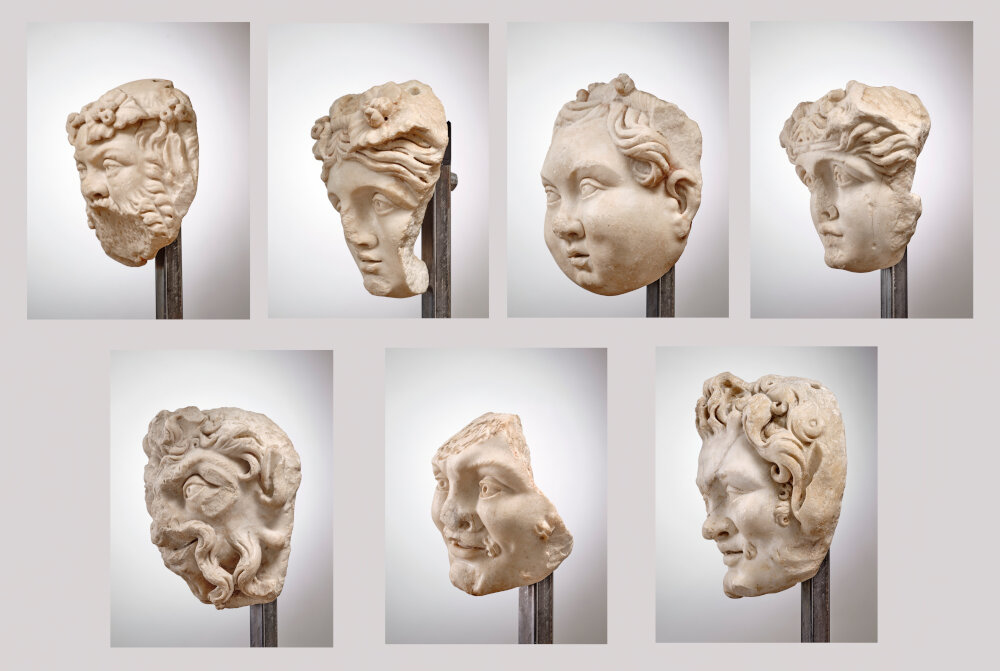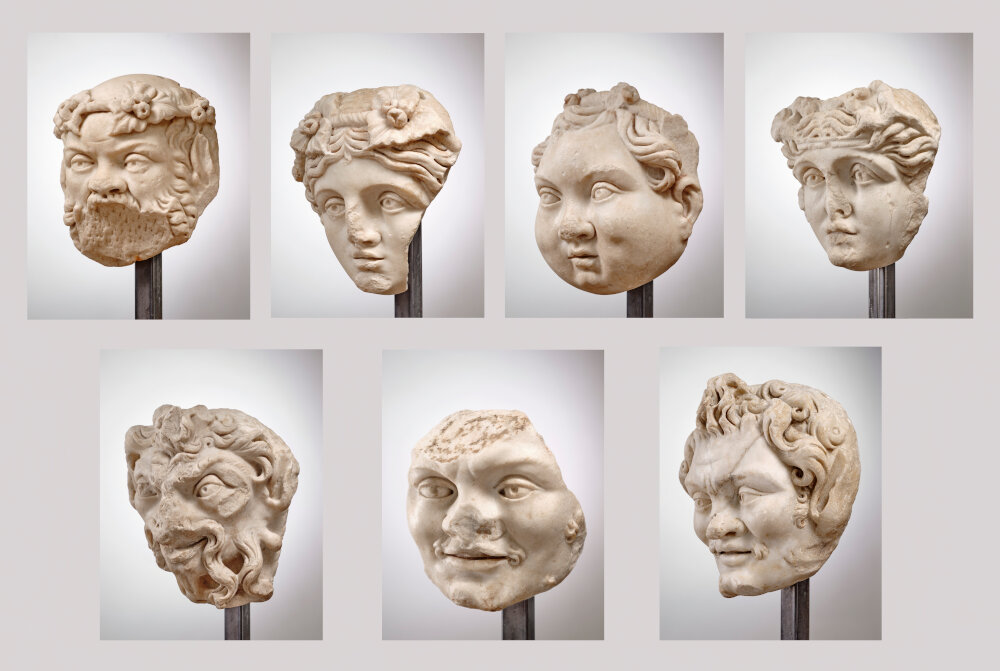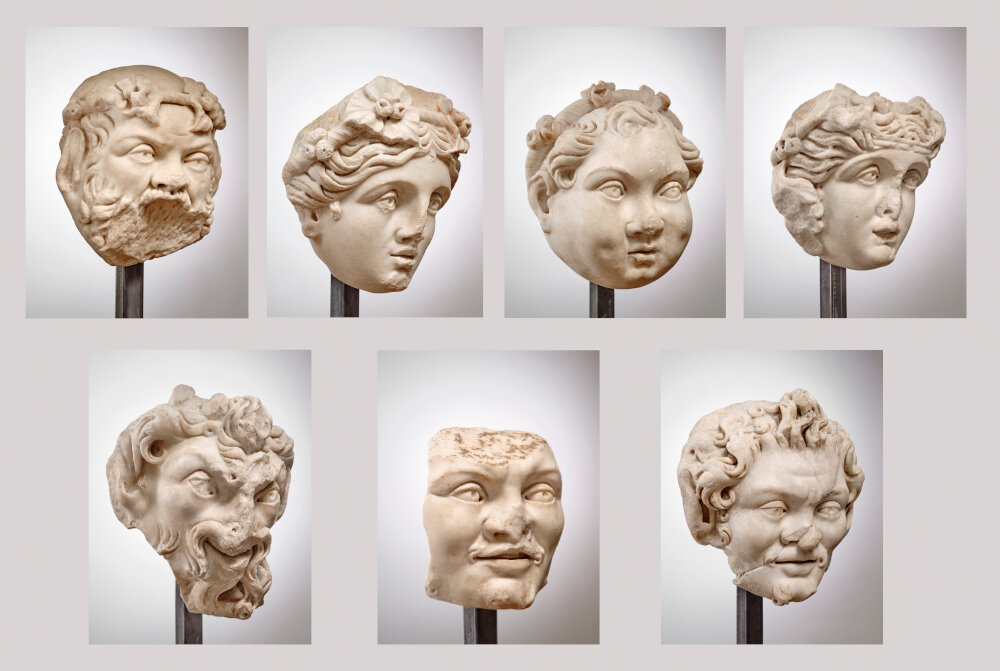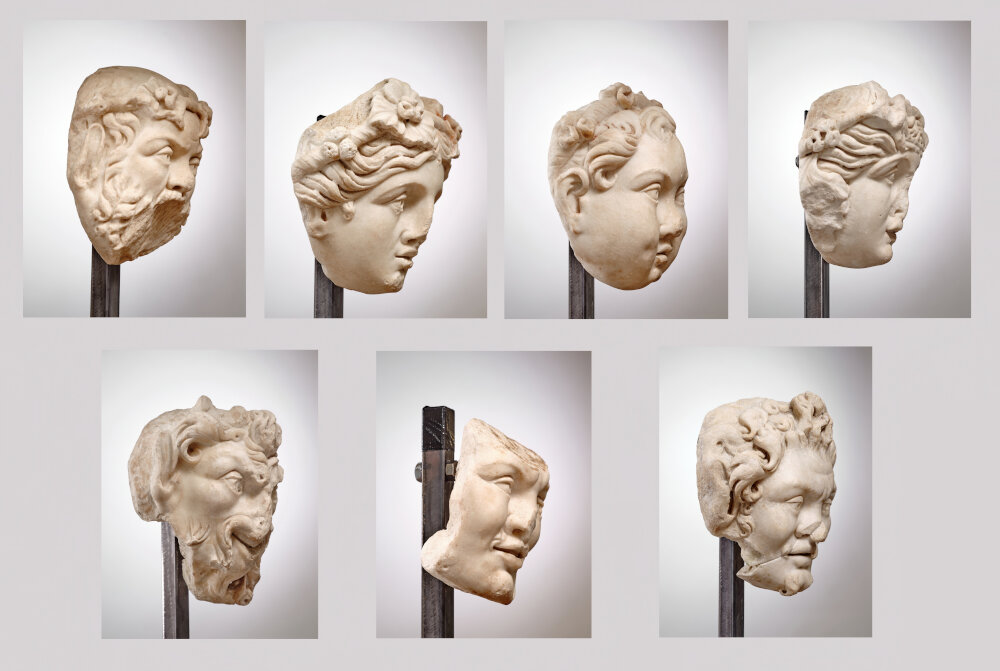Bacchic masks






- Material
- Marble
- Inventory number
- Ra 36 - Ra 37
- Photo credits
- Daniel Martin
These heads, which are hollowed out at the back and intended to be hung on a wall, were undoubtedly part of the villa’s lavish decor during Late Antiquity. And several details even betray the fact that they were all made by the same workshop: the wide strands of hair separated by deep chiselled grooves; the small and perfect circle formed by the curled ends with their deep drill holes; the similarity between the satyr’s hairstyle, with its tuft of hair (7) and that of Eurystheus, in the large relief depicting Hercules and the Erymanthian boar; the eyebrows arched in the shape of an acute angle; the round pupils, hollowed out with a drill bit; and the empty, sinuously-shaped cavities inside their half-open mouths. You only have to compare some of these faces with the representations of Hercules (the hero’s isolated naked head, the one on the relief of the Lernaean hydra, and that of the panel depicting the Erymanthian boar) to see the formal coherence that is specific to this one workshop, and similar to the methods implemented in certain sites in Asia Minor. Finally, it is worth mentioning the material that was used to create this original series, as recently confirmed by analysing most of the sculptures discovered around the villa. Following the example of the Labours of Hercules, the theatre masks, medallions of the gods, portraits of Maximian and his loved ones and, finally, the large series of small and medium-sized mythological representations, these so-called « bacchic » heads were also carved from marble mined in Saint-Béat.
They include a silenus [1], two horae (seasons) or maenads [2, 4], a child Bacchus (?) [3], Pan [5] and two satyrs [6, 7]. It is easy to imagine these marble heads hanging on the walls of a banqueting hall. One mosaic in particular, which decorates the floor of the triclinium in the House of the Labours of Hercules in Volubilis, features both the seasons and the challenges endured by this Greco-Roman hero L.I.M.C., Lexicon Iconographicum Mythologiae Classicae. V. 1, Herakles - Kenchrias, Zürich ; Munich, 1990, Horai/Horae 168.. Could such a combination have existed (in marble form) in a similar area of the Chiragan estate? The association of these demigods refers to the world of Bacchus (the Greek Dionysus), and the succession of seasons symbolises eternity and constant renewal, which is also promised by the god. Here, these horae could represent summer, crowned with ears of corn, and spring, adorned with flower buds. These daughters of Zeus and Themis (goddess of fairness) are therefore in no way contradictory with a Dionysian (or Bacchic) environment. On the contrary, since mythology has, moreover, made these guardians of Olympus the nursemaids of the infant Bacchus/Dionysus. Nonnos de Panopolis, Dionysiaques, 450AD, IX, 11..
P. Capus
Bibliography
- Ensoli, La Rocca 2000 S. Ensoli, E. La Rocca (eds.), Aurea Roma : dalla città pagana alla città cristiana. Mostra, Palazzo delle esposizioni, Roma, 22 dicembre 2000-20 aprile 2001, Rome.
- Beckmann 2020 S.E. Beckmann, « The Idiom of Urban Display: Architectural Relief Sculpture in the Late Roman Villa of Chiragan (Haute-Garonne), » American Journal of Archaeology, 124, 1, pp. 133–160. p. 133-160
- Bergmann 1999 M. Bergmann, Chiragan, Aphrodisias, Konstantinopel : zur mythologischen Skulptur der Spätantike (Palilia), Wiesbaden. p. 26-43
- Bergmann 1995 M. Bergmann, « Un ensemble de sculptures de la villa romaine de Chiragan, oeuvre de sculpteurs d’Asie Mineure, en marbre de Saint-Béat ?, » J. Cabanot, R. Sablayrolles, J.-L. Schenck (eds.), Les marbres blancs des Pyrénées : approches scientifiques et historiques. Colloque, 14-16 octobre 1993, Saint-Bertrand-de-Comminges, Saint-Bertrand-de-Comminges, pp. 197–205. p. 197-205
- Cazes et al. 1999 D. Cazes, E. Ugaglia, V. Geneviève, L. Mouysset, J.-C. Arramond, Q. Cazes, Le Musée Saint-Raymond : musée des Antiques de Toulouse, Toulouse-Paris. p. 82
- Du Mège 1835 A. Du Mège, Description du musée des Antiques de Toulouse, Toulouse. no 267
- Du Mège 1814 A. Du Mège, Monumens religieux des Volces-Tectosages, des Garumni et des Convenae, ou Fragmens de l’archaeologie pyrénéenne et recherches sur les antiquités du département de la Haute-Garonne, Toulouse. p. 262-263, pl. III, no 1
- Du Mège 1828 A. Du Mège, Notice des monumens antiques et des objets de sculpture moderne conservés dans le musée de Toulouse, Toulouse. no 64
- Espérandieu 1908 É. Espérandieu, Recueil général des bas-reliefs de la Gaule romaine, 2. Aquitaine, Paris. p. 48, no 922
- Guillevic, Dupuy, Cazes 1989 J.-C. Guillevic, P. Dupuy, D. Cazes, Toulouse et l’Antiquité retrouvée au XVIIIe siècle. Exhibition, Musée Saint-Raymond, toulouse, 8 June - 27 August 1989, Toulouse. no 2
- Joulin 1901 L. Joulin, Les établissements gallo-romains de la plaine de Martres-Tolosane, Paris. p. 8 et 92-93, pl. VII, 63 A à 70 A
- Martène, Durand 1717 E. Martène, U. Durand, Voyage littéraire de deux religieux bénédictins de la congrégation de Saint Maur, Paris. 2e partie, p. 34-35
- Rachou 1912 H. Rachou, Catalogue des collections de sculpture et d’épigraphie du musée de Toulouse, Toulouse. no 37
- Roschach 1892 E. Roschach, Catalogue des musées archéologiques de la ville de Toulouse : Musée des Augustins, Musée Saint-Raymond, Toulouse. no 37
To cite this notice
Capus P., "Bacchic masks", in The sculptures of the roman villa of Chiragan, Toulouse, 2019, online <https://villachiragan.saintraymond.toulouse.fr/en/ark:/87276/a_ra_36_ra_37>.